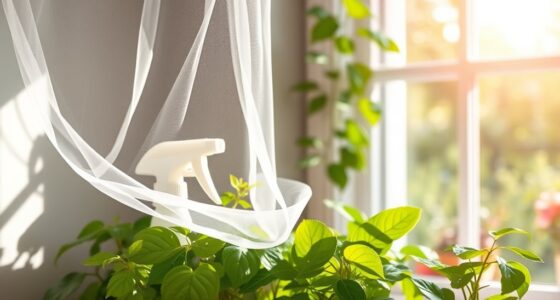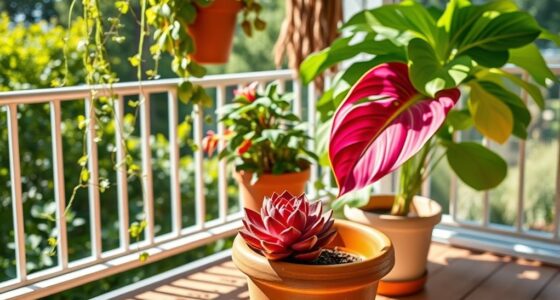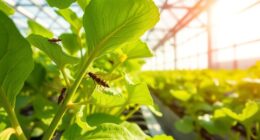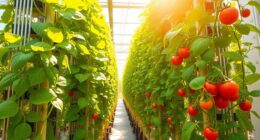To take care of your indoor plants, start by choosing varieties that match your space and light conditions. Water them based on soil moisture, not a set schedule, and use filtered water. Maintain proper humidity levels and temperatures; monitor for signs of stress. Fertilize during their growing season and keep a lookout for pests. Regular grooming and timely repotting help them thrive. There’s plenty more to learn to keep your plants flourishing beautifully.
Key Takeaways
- Choose plants based on lighting conditions, space size, maintenance level, and interior design style for optimal growth and aesthetic appeal.
- Water plants according to their specific needs, checking soil moisture and adjusting frequency based on the season.
- Maintain humidity and temperature levels suitable for each plant type to prevent stress and promote healthy growth.
- Regularly inspect for pests, clean leaves, and prune dead or damaged foliage to maintain plant health and appearance.
- Repot plants in spring using quality potting soil and ensure pots have proper drainage to support root health.
Choosing the Right Plants
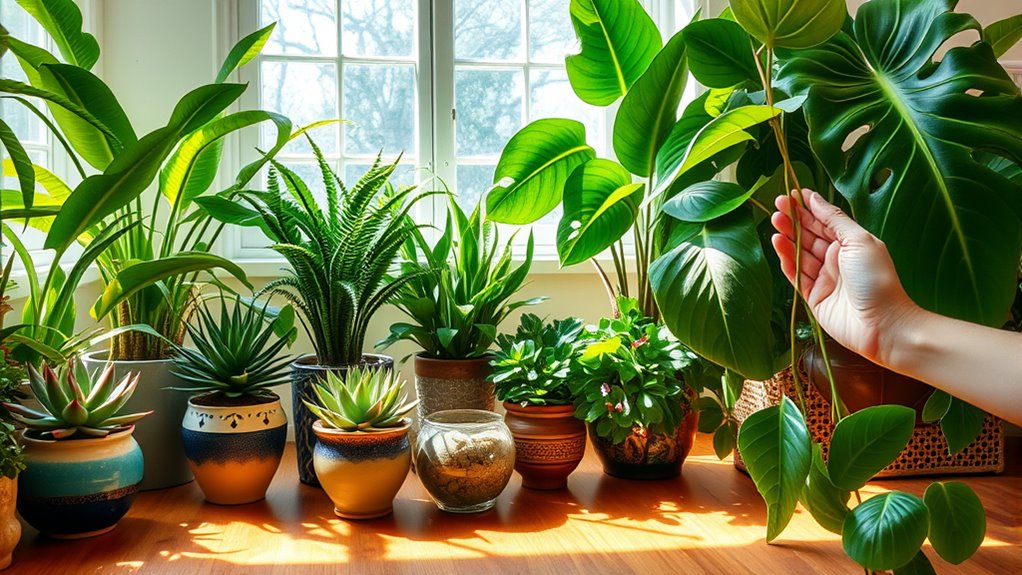
When you’re choosing the right indoor plants, it’s essential to consider your space’s lighting and your lifestyle. Bright light plants like succulents and cacti thrive in direct sunlight, while Philodendron and Pothos prefer bright indirect light.
If your space has low light, opt for a Spider Plant or a Peace Lily. Think about the size of your space too; compact plants like Aloe Vera work well in small areas, whereas larger plants like Bird of Paradise need ample room. Additionally, selecting the right plants can significantly enhance interior design and contribute to the overall aesthetic of your home. Using natural materials like wood for plant stands can further elevate the design. Incorporating textures like wood in your plant decor can also add warmth and depth.
Moreover, the right plant choices can improve indoor air quality, benefiting your overall health and well-being. Match your plants to your interior design style; Monstera fits a minimalist look, and hanging plants like String of Pearls suit bohemian vibes.
Lastly, consider your maintenance level—choose low-maintenance plants if you’re busy, or go for high-maintenance varieties if you’ve got the time.
Watering Techniques

After selecting the right indoor plants, mastering watering techniques becomes vital to their health.
First, check soil moisture by inserting your finger about an inch deep; if it’s dry, it’s time to water. Avoid sticking to a fixed schedule—vary your approach based on the plant’s needs and seasonal changes. DO Water Indoor Plants as Needed to ensure each plant receives the proper hydration it requires. It’s important to note that different plants may have varying shelf life regarding moisture retention, so always be observant. Additionally, larger plants generally need more water due to their increased leaf surface area. Maintaining a clutter-free environment can also enhance the overall health of your plants, as organized spaces promote better air circulation and light exposure.
Check soil moisture regularly; adjust watering based on your plant’s needs and seasonal changes for optimal health.
In winter, plants often need more water, while summer may require less. Use top watering for most plants, but consider bottom watering for delicate varieties.
Always use room temperature, filtered water to prevent shock. Ensure your pots have good drainage to avoid waterlogged soil, which leads to root rot.
Finally, watch for signs like wilting or yellowing leaves to adjust your watering routine effectively.
Lighting Conditions
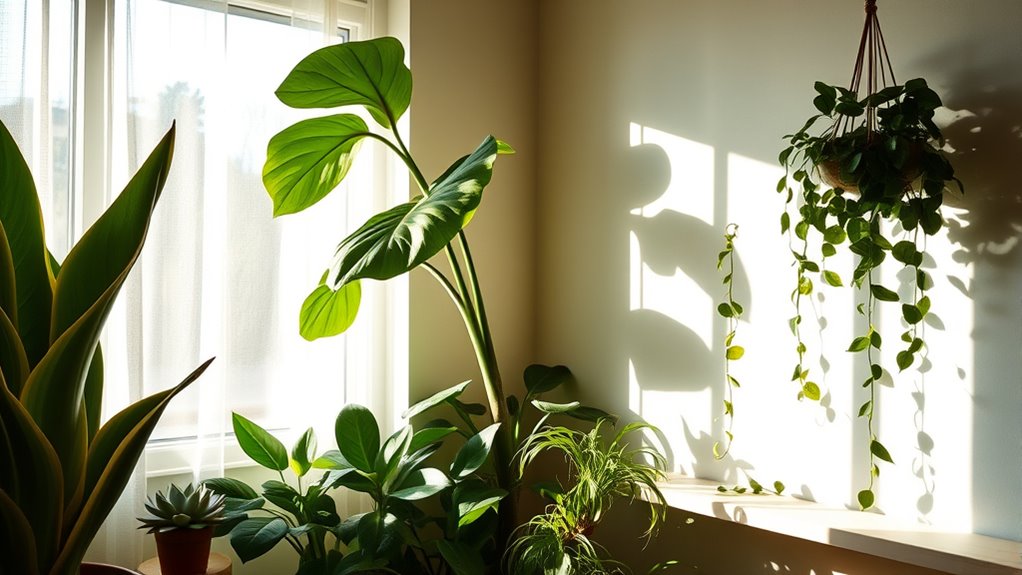
Understanding the lighting conditions for your indoor plants is crucial, as it directly impacts their growth and overall health.
Indoor plants fall into categories based on light needs: low, medium, and high light. South-facing windows provide the most direct sunlight, while north-facing ones offer the least. Most plants thrive with 12 to 16 hours of light daily, combining natural and artificial sources. Light intensity can vary based on factors like window cleanliness and obstructions, so it’s essential to monitor these conditions. Additionally, best home security systems can help protect your indoor plants by monitoring for potential threats like pests or intruders. To enhance your indoor space, consider adding DIY Fire Pit Ideas for a cozy atmosphere that complements your plant care routine. Ensuring proper lighting can significantly reduce the risk of ear pressure issues often associated with poor plant health.
Remember, excessive light can cause damage, while insufficient light leads to weak, spindly growth. Use grow lights to supplement when necessary, and consider the type and cleanliness of your windows.
Be aware of obstructions like trees and buildings, as they can reduce light intensity and affect your plants’ well-being. Adjust accordingly for optimal growth!
Humidity and Temperature
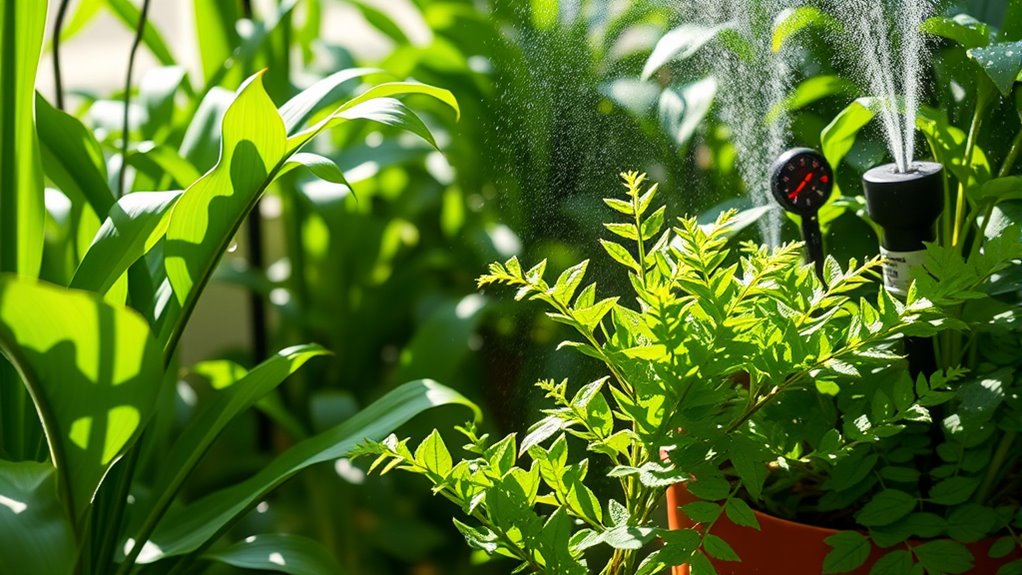
Humidity and temperature play vital roles in the health of your indoor plants, so it’s important to create an environment that meets their specific needs. Most houseplants thrive in temperatures between 18°C and 28°C, while specific plants may have their own preferences. For instance, cacti prefer lower humidity below 40%, while tropical plants need 60% to 90% humidity. Keep an eye out for signs of stress: brown leaf edges signal temperature issues, and curled leaves indicate low humidity. To manage these factors, consider using a humidifier, grouping plants together, or placing pebble trays nearby. Campgrounds often have amenities that can help you understand how to create the right environment for your plants. It is also beneficial to consider building a backyard greenhouse to help regulate temperature and humidity for your indoor plants. Regularly check your thermometer and hygrometer to ensure your plants enjoy optimal conditions for growth and vitality, as most houseplants thrive in a temperature range that supports their health and photosynthesis. Additionally, regular cleaning of the plants’ environment is essential to prevent disease and promote healthy growth.
Fertilization and Pest Control

To keep your indoor plants thriving, proper fertilization and effective pest control are essential. Use organic liquid fertilizers like fish emulsion during the active growth season, applying them every 4–6 weeks. Dilute them to half strength initially to prevent over-fertilization. Plants require sixteen elements for optimal growth, so ensuring a balanced nutrient supply is crucial. Additionally, maintaining a healthy soil quality will support robust plant growth. Essential oils can also enhance indoor air quality, contributing to a healthier environment for your plants. Regularly using an air purifier can further improve the air quality indicators in your space, benefiting both you and your plants.
Remember to adjust your fertilization schedule in fall and winter when growth slows.
For pest control, regularly inspect your plants for common pests like spider mites or aphids. Clean your plants to deter pests and isolate any infested ones.
Use neem oil or soap solutions for mild infestations. Maintain healthy plants with good soil quality and humidity management, as healthy plants are less prone to pests.
Regular monitoring helps catch problems early, ensuring your plants stay healthy and vibrant.
Grooming and Repotting
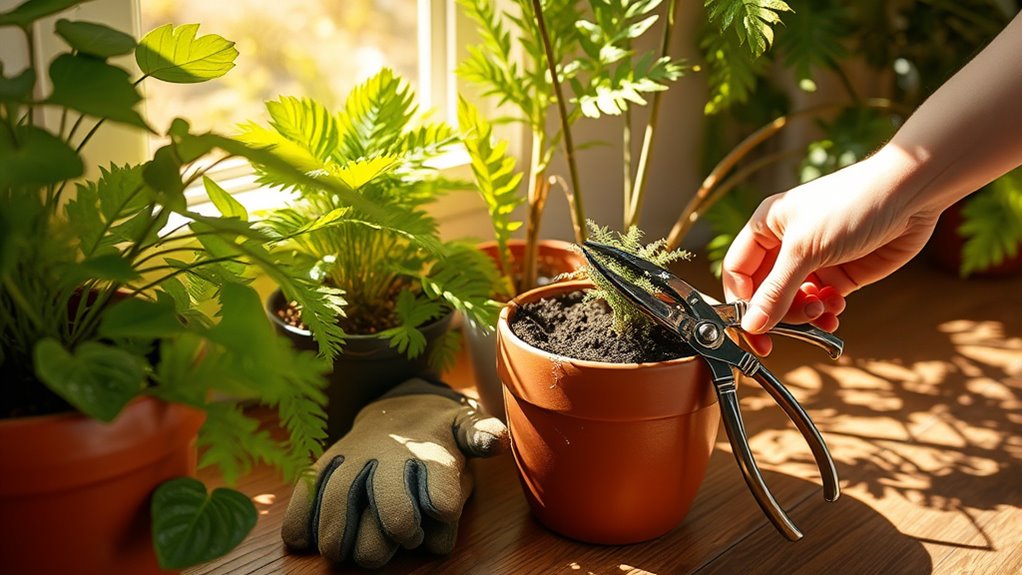
Grooming and repotting your indoor plants are vital tasks that help maintain their health and appearance. Start by cleaning leaves with a soft cloth to remove dust, which boosts photosynthesis. Regularly remove dead or damaged leaves to redirect energy toward healthy growth. Trim brown edges to keep your plants looking sharp and prevent decay. To support optimal growth, consider pruning and training as additional methods to enhance your plants’ structure and health. Additionally, regular grooming of your indoor plants can help control pests that may affect their well-being. Using non-toxic materials for plant care can further ensure a safe environment for your indoor gardening efforts. Furthermore, choosing self-watering pots can simplify the watering process and promote healthy root growth.
When it comes to repotting, choose high-quality potting soil and pots with good drainage to avoid root rot. Spring is the best time for repotting. Handle roots gently to minimize stress, and provide extra water afterward to aid recovery. Regular grooming and timely repotting ensure your indoor plants thrive, showcasing their beauty in your home.
Seasonal Care Tips
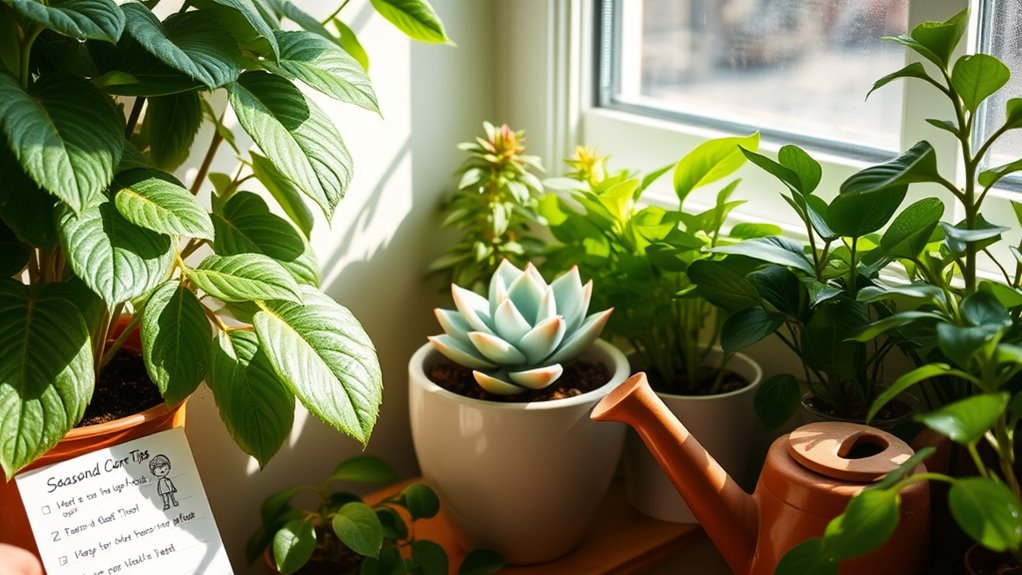
As the seasons change, your indoor plants require tailored care to thrive.
In winter, increase light by moving them closer to windows or using grow lights. Spindly new growth indicates a need for more light, so be attentive as days grow shorter. Additionally, consider the impact of temperature variations on plant health, as they can significantly affect growth. During this time, be mindful of how gold serves as a hedge against economic uncertainty, as a similar principle applies to protecting your plants from environmental stressors. Spring brings longer days; ensure they get adequate sunlight without harsh exposure, especially since skincare products dominate market share, highlighting the importance of proper care for your plants. During summer, keep plants away from intense direct sunlight, particularly at peak hours. In autumn, maintain consistent light exposure as daylight decreases.
Temperature matters too: keep plants away from drafts in winter and monitor rising temps in spring.
Water less in winter and increase frequency in spring, ensuring consistent moisture in summer. Boost humidity in winter and check levels regularly.
Finally, pause fertilization in winter, resume in spring, and reduce frequency in autumn to match their growth cycles.
Frequently Asked Questions
How Do I Know if My Plant Is Dying?
To know if your plant’s dying, look for yellowing leaves, which often signal watering issues.
Brown or curling leaves might indicate underwatering or pests.
Check for squishy leaves, suggesting overwatering, and inspect the roots; damaged roots can mean root rot.
Observe the light conditions and ensure they’re suitable.
Finally, if the plant has a foul odor, it’s a sign of trouble.
Regular checks can help you catch these issues early.
Can I Use Tap Water for My Plants?
You can use tap water for your plants, but be cautious.
It often contains chlorine and fluoride, which can harm sensitive species. If you’re concerned, let the water sit for 24 hours to evaporate chlorine, or consider using a water filter.
Rainwater and distilled water are excellent alternatives that avoid potential contaminants.
Check your plants regularly; if they’re showing stress, it might be time to explore better water options.
When Is the Best Time to Repot My Plants?
The best time to repot your plants is during fall, late winter, or spring.
These periods align with slower growth or increased natural light, helping your plants adjust without stress.
You can also repot in summer if you have tropical houseplants that are actively growing.
Just keep an eye on your plants and avoid repotting during peak growth seasons unless absolutely necessary.
This way, you’ll ensure they thrive in their new homes.
What Common Pests Should I Look for on My Plants?
You should watch out for common pests like aphids, mealybugs, and spider mites on your plants.
Aphids cause yellowing and deformed leaves, while mealybugs leave fluffy white patches and sticky residue.
Spider mites create fine webbing and speckled leaves.
Keep an eye out for fungus gnats buzzing around and scale insects, which appear as small bumps.
Regular inspections help you catch these pests early, ensuring your plants stay healthy and thriving.
How Can I Propagate Indoor Plants Effectively?
To propagate indoor plants effectively, start by taking cuttings from a healthy parent plant.
Use clean, sharp tools to cut stems at an angle, removing lower leaves.
Place your cuttings in a warm, humid spot with bright, indirect light.
Use a rooting medium like vermiculite for better drainage.
Water thoroughly but avoid over-saturation.
Monitor your cuttings for new growth and be ready to fertilize lightly once they establish roots.
Conclusion
Taking care of indoor plants can transform your space into a vibrant oasis. By choosing the right plants and understanding their needs, you’ll create a thriving environment. Imagine walking into a room filled with lush greenery, the air fresh and inviting. With proper watering, lighting, and occasional grooming, your plants will flourish. So, why not embrace the joy of nurturing these green companions? They’ll reward you with beauty and tranquility for years to come.




